The Morning Moon Brings Spring Galaxies and Inner Planets Prance at Sunset, so I Mention Mercury and Guide you to Galaxies!

This spectacular photograph by Alan Dyer of Alberta, Canada captured Venus’ swing past the Pleiades Star Cluster, or the Seven Sisters, on Tuesday, April 3, 2012. The image, spanning about two fingers widths of the sky, nicely shows the mini-dipper shape of the stars that you would see through binoculars. Alan’s original blog post is at https://amazingsky.net/2012/04/03/venus-meets-the-seven-sisters/
Hello, mid-April Stargazers!
Here are your Astronomy Skylights for the week of April 9th, 2023 by Chris Vaughan. Feel free to pass this along to your friends and send me your comments, questions, and suggested topics. You can also follow me on Twitter as @astrogeoguy! Unless otherwise noted, all times are expressed in Eastern Time. To subscribe to these emails please click this MailChimp link.
If you’d like me to bring my Digital Starlab portable inflatable planetarium to your school or other daytime or evening event, or deliver a session online, contact me through AstroGeo.ca, and we’ll tour the Universe, or the Earth’s interior, together! My terrific book with John A. Read entitled 110 Things to See With a Telescope is a guide to viewing the deep sky objects in the Messier List – for both beginners and seasoned astronomers. DM me to order a signed copy!
The moon will spend this week and next in the morning sky, so Northern Hemisphere stargazers can enjoys lovely views of spring galaxies, or the Milky Way’s gems down under. This week also brings the best views of speedy, elusive Mercury for 2023, joining brilliant Venus in the western sky after sunset. I suggest some galaxies to see and cite some interesting facts about Mercury. Read on for your Skylights!
Yesterday, April 8, 2023, marked one year until the spectacular North American Total Solar Eclipse that will race northeast from northern Mexico, through central Texas, Indianapolis, Cleveland, Hamilton, Ontario and Buffalo, New York, through southeastern Quebec, New Brunswick, and across Newfoundland. Eyeing typical early April weather, it’s not too soon to plan where you’ll view this spectacular event! Close doesn’t count. You’ll want to be inside the moon’s 200-km wide shadow zone.
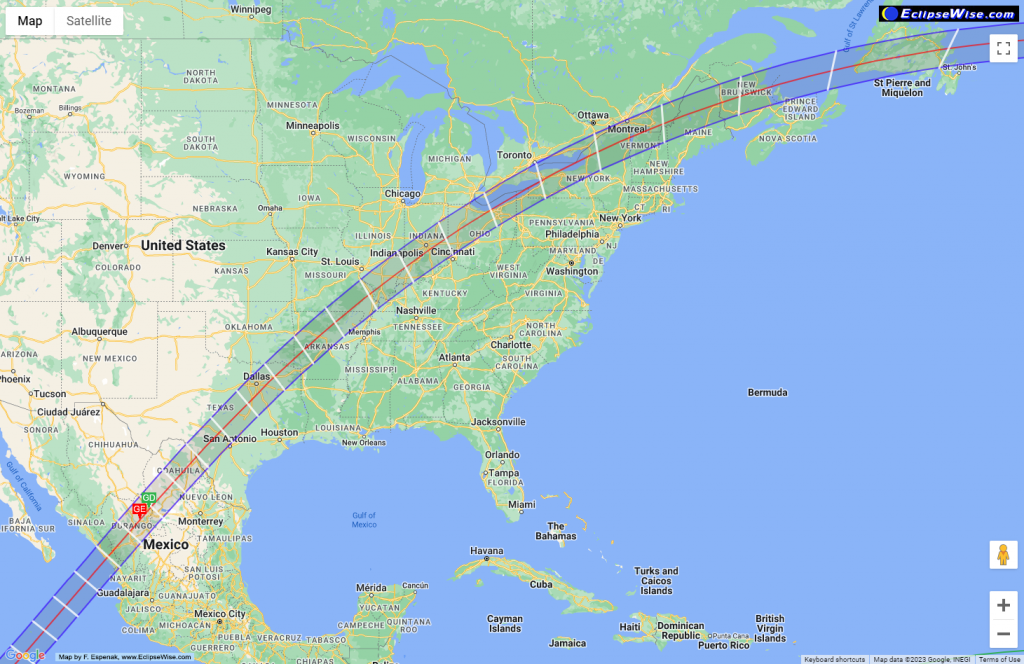
The Moon
The moon will not be shining in the evening sky at all this week. Instead, our planet’s partner will be approaching the sun and visible only in the hours before dawn and during morning daylight. That means astronomers worldwide will be pulling out their telescopes to look at the best of the sky’s delights. In the Northern Hemisphere, it’s galaxy viewing season! In the Southern Hemisphere, the Milky Way will arc high overhead, bejeweled with the many nebulae and star clusters within its bounds.
When the still-bright, waning gibbous moon rises over the southeastern horizon just after midnight local time tonight (Sunday), it will be shining very close to the upper left (or celestial northeast) of bright reddish star Antares, the heart of Scorpius (the Scorpion). By the time you are sipping your morning coffee, the moon will be low in the southwestern sky and a little farther from Antares.
As the week unfolds the moon will continue to rise later, wane in phase, and linger longer into the morning daylight. It’ll spend Tuesday morning near the eastern foot stars of the Serpent-Bearer, Ophiuchus, and Wednesday-Thursday crossing the Teapot-shaped stars of Sagittarius (the Archer).
The moon will reach its third quarter phase on Thursday at 5:11 am EDT or 2:11 am PDT and 09:11 Greenwich Mean Time. At third, or last, quarter the moon is half-illuminated on its western side, towards the pre-dawn Sun. On Friday and Saturday morning the less than half-full, the waning crescent moon will swim through Capricornus (the Sea-Goat) – but you’ll likely only spot the bright dot of nearby Saturn to its left as the surrounding constellations are rather lusterless.

Look a short distance above the southeastern horizon before dawn on Sunday morning to see the slender crescent of the old moon shining several finger widths below (or 4.7 degrees southeast of) magnitude 1.0 yellowish Saturn, allowing them to share the view in binoculars. The scene will make a nice widefield photo when composed with some interesting foreground scenery.
It’s Spring Galaxy Time!
Every spring in the Northern Hemisphere, the obscuring stars, gas and dust of our own Milky Way galaxy vacate the night sky overhead, leaving a literal window of opportunity for observers to see distant galaxies. The completely moonless evenings that commence around Wednesday will provide us with the dark skies we need for seeing these faint, but majestic objects. The darkness will last through April 22. If you don’t have clear skies, the next viewing opportunity will return towards mid-May.
On a clear, moonless evening, find a spot away from city lights and look east. About halfway up the sky, to the upper right of the very bright star Arcturus, you’ll find the modest stars of the constellation of Coma Berenices, or “Bernice’s Hair.” Its patch of sky contains the north galactic pole and therefore far fewer stars than the rest of the sky. Coma, for short, climbs high overhead in late evening during April and in mid-evening during May – perfect for viewing distant galaxies through the least amount of Earth’s distorting atmosphere. Coma Berenices and the constellations around it – Virgo (the Maiden), Leo (the Lion), Ursa Major (The Big Bear, and the Big Dipper’s home) and Canes Venatici (the Hunting Dogs) – all host a great many galaxies.
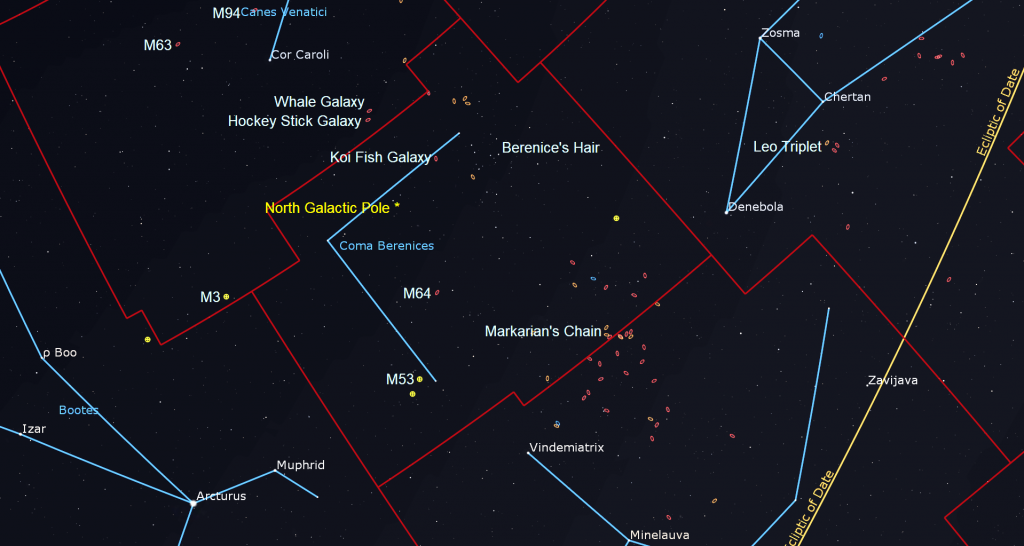
If you have a good-sized telescope (say a 4” or 102 mm aperture telescope, or larger) and a dark location that is free of light pollution, put your lowest power eyepiece (or lens) in it. That’s the one with the largest number printed on it. That long focal length eyepiece will show the largest possible patch of sky through a telescope – making finding galaxies easier. (You can also see many of the following targets in larger binoculars from dark sites.)
Now aim your telescope at the medium-bright star named Denebola, which marks the tail of Leo (the Lion), and focus it until Denebola is a pinpoint of light. Next, without changing the focus, aim at the spot exactly midway between Denebola and the medium-bright star Vindemiatrix in Virgo (the Maiden), which sits nearly two outstretched fist diameters to the lower left (or 17 degrees to the celestial east) of Denebola.
If your sky is dark and your eyes are dark-adapted, you should see a number of dim, fuzzy patches in the eyepiece. Those are members of the Virgo Cluster of Galaxies – some larger, some smaller. If you can’t be sure you’re seeing them, try lightly tapping telescope tube while you are looking. The smudges will jump around a little, allowing your brain’s wiring to see them better. Nudge the telescope around to see how many you can find. (There are dozens in that patch of sky). If you mess up the focus, or get lost, just start over.
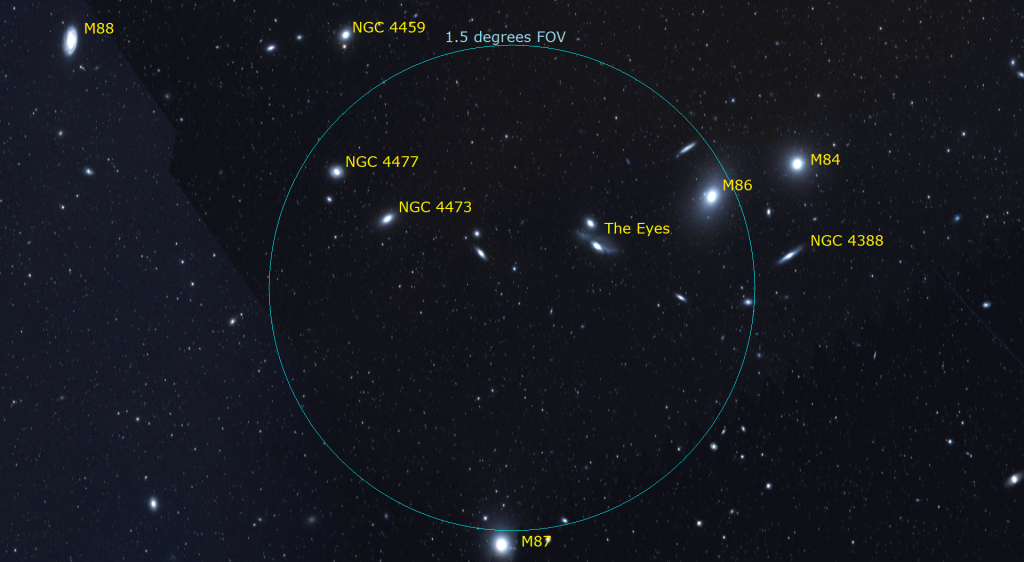
The biggest and brightest galaxies in that neighbourhood are designated Messier 84 and Messier 86 (or M84 and M86). They are part of a curved line of galaxies known as Markarian’s Chain. In the early 1960’s, Armenian astrophysicist Benjamin E. Markarian discovered that those galaxies were travelling through the Universe as a gravitationally-bound group. Depending on your telescope type, their arc will curve down to the right or up to the right. Another prominent galaxy called M87 is located a short hop from the bend in the chain. If you recall the pictures in the news (four years ago this month) of an orange ring surrounding a Black Hole, M87 is the galaxy where it is located, some 60 million light-years away from us. Here’s the press release.
Galaxies that are oriented edge-on towards Earth appear in telescopes as short, indistinct, streaks of dim light. That’s because we’re seeing the collective light from all of that galaxy’s stars squeezed into a much smaller area of sky. Try to find the star named Gamma Comae Berenices (or γ Com or Al Dafirah). It’s close to the limit of visibility in light polluted skies, but easier to see in rural locations. That star is the uppermost of Coma Berenices’ three main stars. A collection of slightly dimmer stars gathered just to the right of Al Dafirah represents the hair of Berenice. Those are easy to see using binoculars. Other names for the cluster include Ariadne’s Hair, Thisbe’s Veil, the Cobweb Cluster, the Flying Witch, Black Bart’s Hair, and Melotte 111.

From Al Dafirah, aim your telescope a slim palm’s width to the left (or 5.5 degrees to the celestial northeast). There you might glimpse the Whale Galaxy (or NGC 4631). It’s called that because, when combined with a second, smaller galaxy sitting just beside it, it resembles a whale blowing water from its spout. Another prominent galaxy called the Crowbar Galaxy, or Hockey Stick Galaxy (or NGC 4656) is positioned close enough to the whale to show up in the same field of view of your telescope. It, too, appears as a slim, fuzzy slash of light. Those two major galaxies are about 25 and 30 million light years away from us, respectively.
Returning to Al Dafirah, scan your telescope two finger widths to the lower left (or 2 degrees to the celestial east) of that star – in the direction of Coma’s brightest star Beta Com – and look for the Koi Fish Galaxy (or NGC 4559). Finally, point your telescope a few fingers widths below (or 3 degrees to the celestial southeast of) Al Dafirah. There you can look for the Needle Galaxy (or NGC 4565). This galaxy is dimmer than the other two, but it sits exactly edge-on to us – making it easier to see. It is located about 57 million light-years away from our solar system!
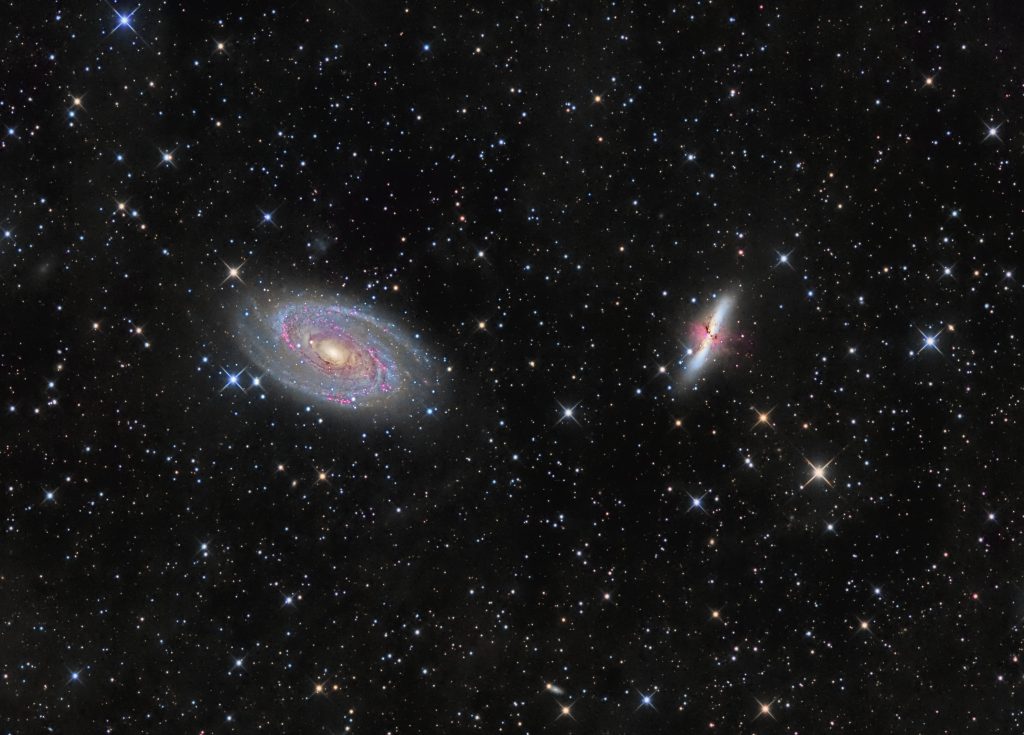
The Big Dipper asterism and its home constellation of Ursa Major (the Big Bear) are very high in the northern sky in late evening during early April – ideal for observing the spectacular galaxies they host in strong binoculars or backyard telescopes on moonless nights this week. Double the line connecting the dipper stars Phecda to Dubhe to arrive at the galaxy named Bode’s Nebula, otherwise known as Messier 81. It’s a magnitude 6.9 spiral galaxy oriented not quite face-on to Earth, making it appear relatively large and bright. A smaller, magnitude 8.4 galaxy named the Cigar Galaxy or Messier 82 is located half a degree to the north. That allows both galaxies to be viewed together in the eyepiece of a telescope at low magnification. Several other fainter galaxies can be found within a few degrees of Bode’s Nebula – so scan around.
Under dark sky conditions, two impressive galaxies can be seen in binoculars and backyard telescopes by using Alkaid, the bright star that marks the tip of the Big Dipper’s handle. The Pinwheel Galaxy, or Messier 101, is a spectacular and large, face-on spiral galaxy positioned a palm’s width to the left (if facing east) or 5.5 degrees to celestial north of Alkaid, forming an equilateral triangle with Mizar, the double star at the bend of the handle. This relatively close galaxy, only 21 million light-years away, is nearly as large as the full moon in the sky. Since the galaxy’s light is spread over such a large area, its overall brightness is low, however.

Aim your binoculars or telescope several finger widths to the upper right of Alkaid to discover the iconic Whirlpool Galaxy, aka Messier 51. This spiral galaxy’s angular size is smaller, but it will look somewhat brighter in your binoculars and telescope. A secondary galaxy core designated NGC 5195 sitting alongside M51 is linked to the main spiral by a bridge of material (stars and dust).
Let me know how you make out with your galaxy search!
The Planets
Once again this week, Venus and Mercury will be the main attraction for evening planet enthusiasts. Although Mars and Uranus will share the sky with them, the two innermost planets will be far brighter.
If you live in a place with lots of urban development, or one that’s hilly or has lots of tall trees, you have probably never seen Mercury. Not because it’s insufficiently bright, but because the planet only appears about six times a year for two or three weeks at a stretch. And when it does appear, it might not climb high enough to clear the surrounding terrain, or linger after sunset long enough to shine in a dark sky. Timing is another problem. Mercury alternates between morning and evening appearances, so late risers’ miss half of the opportunities!
Since last week, the innermost planet has been swinging away from the sun every day – allowing it to set later and later. On Tuesday evening Mercury will reach a maximum angle of 19.5 degrees from the sun – delivering maximum visibility for its current evening appearance. Astronomers call that its greatest eastern elongation. Mercury’s position north of the upright evening ecliptic will make this the best evening appearance of the planet for Northern Hemisphere observers in 2023 – so take the opportunity to check off this item on the bucket list!

There’s no need to wait for Tuesday. If you have a clear sky to the west, once the sun has completely disappeared, you can begin to sweep the sky above the west-northwestern horizon. (The same place where the sun set.) The planet will be readily visible by 8:30 pm, shining with a bright magnitude of -0.3 and a fist’s width above the horizon. In a telescope the planet will exhibit a nearly half-illuminated phase and an apparent disk diameter of 7.7 arc-seconds – but your view might be blurred by the quintuple thickness of Earth’s atmosphere you’ll be seeing it through. Around 9 pm local time the stars of central Aries may appear to Mercury’s right. After Tuesday Mercury will decrease in brightness and drop lower a bit each night. You’ll still be able to see it into next week – especially if you’ve already had some practice! Take care to avoid aiming a telescope or binoculars near the sun. I’ve written more about Mercury’s interesting history and its science below.
Venus, too, is pulling away from the sun, brightening a little each night, and lasting longer into evening. Unlike Mercury, our sister planet will grace the western evening sky until summer. As the sun is setting the magnitude -4.1 planet, fifty times brighter than Mercury, will appear one third of the way up the western sky. Venus will descend and set around 11:30 pm in your local time zone. Long before then the darkening sky will reveal the brightest stars of Taurus (the Bull) around it.
Venus’s orbital motion has been carrying it towards the Pleiades star cluster which is also known as Messier 45. Tonight (Sunday), that bright little clump of stars that resembles a miniature dipper will sit a few finger widths to the upper right (or 3° to the celestial north) of Venus. That’s close enough for them all to share the view in your binoculars. Those stars are 25 million times farther away than Venus! Venus will move a little closer to the Seven Sister stars on Monday and Tuesday, and then it will draw farther to their upper left in the nights ahead. Venus’ position among the celestial sphere repeats every eight years. In 2020, she flew through the centre of the Pleiades. She’ll do it again on April 3, 2028. I’ll post a photo of a previous close pass here.

Viewed in a telescope this week, Venus will display a gibbous 73%-illuminated disk that is waning daily. To see Venus’ rugby ball shape most clearly in a telescope, view the planet as soon as you can locate it through your optics, when it will be higher and shining through less intervening air.
The small blue-green dot of Uranus will be positioned between Mercury and Venus this week, but the distant magnitude 5.84 planet will be tough to see. By the time the sky darkens enough to see it, around 9 pm, it will be low enough in the sky to be affected by that five times thicker air mass. Each night it will be carried lower towards Mercury.
Mars continues to fade in brightness and become smaller in telescopes as Earth increases its distance from the red planet. After dusk tonight (Sunday), the red-tinted dot of Mars will appear in western Gemini (the Twins), about two-thirds of the way up the west-southwestern sky. That will be its best telescope viewing time – while it’s perched on high – but it will look tiny under any magnification. Reddish Mars will form a large triangle above ruddy Betelgeuse at Orion’s shoulder and well to the upper left of the bright, reddish star Aldebaran, which marks the angry eye of Taurus (the Bull). Mars is noticeably fainter than those stars now. The planet will set during the wee hours of the night.

Mars’ easterly orbital motion on the northern side of the ecliptic continues to help it to delay its inevitable descent into the west until July. To see its motion for yourself, note its position with respect to the nearby star Mebsuta every few nights. On Friday night, Mars will pass telescope-close to the left (or celestial southeast) of Mebsuta, but even your unaided eyes or binoculars will be able to see the close pair.
If you have a clear view of the east-southeastern horizon, watch for the yellowish dot of Saturn before sunrise, especially if you live closer to the tropics. Except for visits by the moon, as on Saturday and Sunday morning, this coming weekend, it will be the lone morning planet until Jupiter joins the party in late May. Jupiter will pass the sun at conjunction on Tuesday. I’ll post sky charts for this week’s observable planets here.
Mercury
Mercury is the smallest planet in the solar system and the closest one to the sun. It is about 40% larger than Earth’s moon. It is smaller than both Ganymede and Titan, moons of Jupiter and Saturn, respectively, but its bulk density of 5.43 g/cm3, almost identical to Earth’s, makes it more massive than those big icy moons. Mercury is a terrestrial planet. It is composed of 70% metallic elements in its iron core, and 30% silicate minerals in its crust and mantle.
There are three prevailing theories for Mercury’s oversized core. If the sun began shining before Mercury fully coalesced, the solar wind may have cleared away a lot of the lighter elements before they could be added to the planet – limiting the mass available for its outer layers. If the planet formed at the same time as the sun, Mercury’s outer, lighter crustal silicates could have been later stripped away by the glancing blow of a large planetoid (the same way we think Earth’s moon formed), or by the solar wind “sandblasting” Mercury over billions of years.
We know that Mercury has been struck countless times. Its surface resembles the moon’s, complete with smaller version of the dark lunar maria. Due to its twice as strong gravity, Mercury’s craters tend to have less prominent rims than the moon’s. There is no plate tectonics activity to erase its ancient scars, but there may be recent or ongoing volcanic activity. The planet also bears cross-crossing linear scarps or cliffs that may have arisen when the warm planet cooled and shrunk.
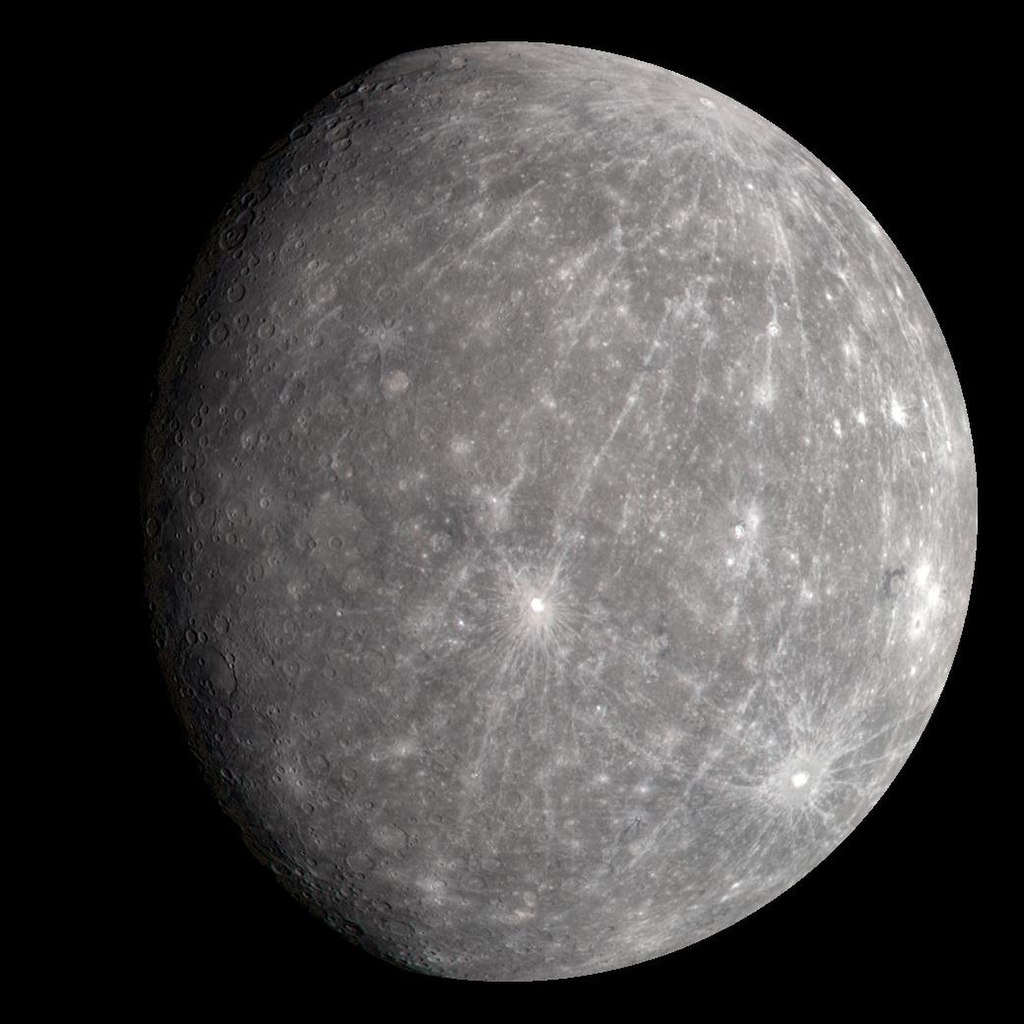
Two spacecraft have explored Mercury – so far. The Mariner 10 spacecraft was launched on November 3, 1973 and performed three close flybys in 1974-75. The flybys, which helped to slow the spacecraft down, skimmed over the planet’s surface taking detailed photographs of half the planet. It discovered that Mercury has a significant magnetic field, likely due to rotation of its iron core, and a tenuous atmosphere. The MESSENGER mission was launched on August 3, 2004 and also flew close to Mercury three times before entering orbit on March 18, 2011. Among the discoveries made were abundant ice in its polar craters, that there has been volcanism on Mercury. It photographed in detail the entire planet. A mission named BepiColombo will enter orbit in December, 2025.
The earliest known record of Mercury is “the jumping planet” inscribed on the Babylonian MUL.APIN tablets circa 1,000 BCE. It was also mentioned in works by Ptolemy, who lived from 100 to 170 CE. The Greeks named the planet for Hermes, their fleet-footed herald of the gods. The Romans used their own version of the same deity, Mercurius. The ancient Chinese called Mercury “the Hour Star” and later it became ShuiXing “the Water Star”, one of the five elements all represented by the bright planets. The Maya may have viewed the planet as an owl that carried messages from the underworld – perhaps because it frequently climbed the sky and then dove down below the horizon.
Once the telescope was adopted for astronomy by Galileo in 1610, Mercury’s phases became apparent under magnification, confirming that it must orbit the sun. On November 7, 1631, the French natural philosopher Pierre Gassendi observed a transit of Mercury across the sun’s disc that had been predicted by Johannes Kepler in 1630. On May 3, 1661 the Polish astronomer Johannes Hevelius observed another transit of Mercury and published his study of it, including drawings of Mercury’s phases shown here.
In the 19th and early 20th century, various astronomers attempted to map mercury’s surface features. Eugenios Antoniadi published a book in 1934 that included both maps and his own observations carried out during daytime while Mercury was high in the sky and much clearer through his 82 cm diameter refractor telescope. Many of the planet’s bright and dark (or albedo) features take their names from Antoniadi’s map, which is available here. Today, Mercury’s cliffs are assigned names after the ships of famous explorers, including Beagle Rupes, the ship on which naturalist Charles Darwin sailed around the world. Craters on Mercury are named after famous deceased artists, musicians, or authors.
Mercury orbits the sun every 88 days, its sidereal period, or Mercurian year. It has an extreme orbital eccentricity of 0.21, so its distance from the sun ranges from 46 to 69.8 million km (or 0.31 to 0.47 Astronomical Units, the mean Earth-sun distance) Those extremes yield 17 times stronger tidal forces than Earth’s moon feels and a highly variable orbital speed. At perihelion it moves 50% faster than at aphelion!
Due to tidal forces between Mercury and the sun, it rotates much more slowly than Earth. Mercury’s 3:2 spin-orbit resonance with the sun, mainly due to its orbital eccentricity, produces one solar day on Mercury for every two Mercurian years. During perihelion, the sun seems to hang in the same place in the sky for 2-3 weeks, preferentially heating that spot on the planet’s equator to 700 K or 426° C. On alternate Mercurian years, that spot switches to the opposite side of the planet. Conversely, there are two sites at 90° to the hot spots that are anomalously cooler because at aphelion the sun crosses the sky over them faster and is farthest away. The temperature on the dark side of the planet average 110 K or -163° C.
Scientists decided to centre Mercury’s coordinate system prime meridian at one of the hot spots. (Earth’s prime meridian crosses through Greenwich, UK.) Since the 0° W longitude was in darkness when Mariner 10 flew by, no visible crater could be assigned to label the spot. Instead, the photographed equatorial crater named Hun Kal was chosen to define the 20° W meridian.
Mercury has almost no axial tilt, leaving the craters at the poles in permanent shadow. That has allowed the ice deposits inside them to survive the nearby sun.
Relative to Earth, Mercury’s perihelion is precessing by 5,600 arc-seconds or 1.55° per century. 42.98 arc-seconds of that drift is attributable to the curvature of spacetime, as predicted by Einstein’s General Theory of Relativity. The rest of the precession is due to gravitational perturbations from the other planets and the torque exerted by the non-spherical shape of the sun. The same relativity phenomenon perturbs Earth’s perihelion by 3.8 arc-seconds per century.
Viewed from Earth, Mercury alternates its appearances between the morning and evening sky. Its maximum angular distance from the sun, or elongation, never exceeds 28° east (for its evening appearances) or west (for its morning appearances). Its minimum elongations are 17°. That means we only ever see it with unaided eyes before dawn or after dusk. On average, Mercury is the closest planet to Earth (and all of the other planets). Even though Venus orbits the sun between Mercury and Earth, it can get much closer to us than Mercury, but it also spends a lot of time much farther away from us.
Mercury’s orbital inclination of 7° causes it to wander well north and south of the plane that the rest of the planets orbit in. That invariable plane line is only tipped by 1.5° with respect to the ecliptic, so they are effectively the same imaginary line across the sky. The quality of a Mercury appearance is controlled by its amount of elongation, the slope of the ecliptic, and Mercury’s declination, i.e., how far it is from the ecliptic and whether it is above it (celestial north) or under it (celestial south).
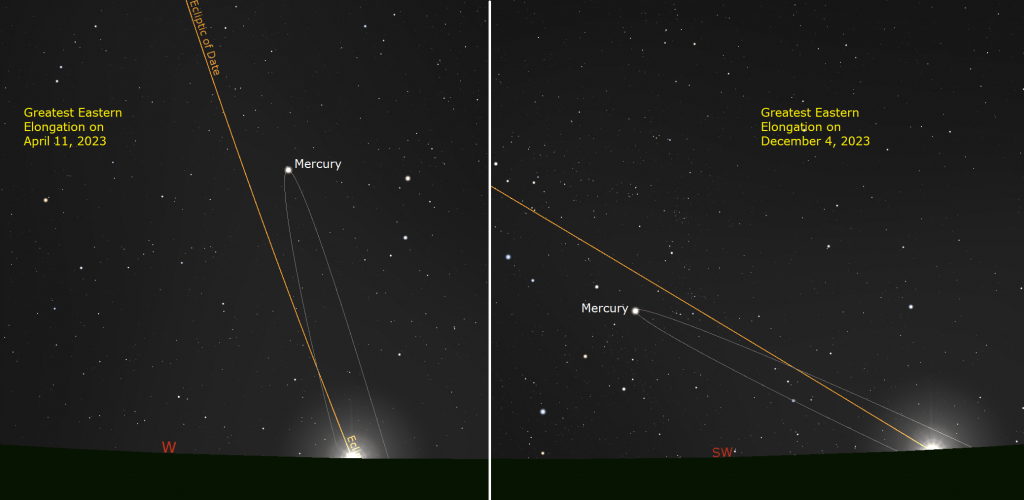
Even small elongation appearances can be of high quality if Mercury is well above a tilted ecliptic. On the same day, the ecliptic’s slope can be much different for mid-northern and mid-southern latitude observers, so your location controls the quality of the apparition, too.
Since we view Mercury from a moving platform (Earth), the appearance intervals alternate between 73 days and 45 days, and Mercury’s illuminated phase repeats at the sum of those two, or ~116 days, also known as Mercury’s synodic period. (The moon’s synodic period, full moon to full moon for example, is 29.5 days.)
For Canadians and other mid-northern latitude observers, March-April evening and September-October morning apparitions are best. Due to Mercury’s eccentricity, some apparitions last longer than others and Mercury can be easily seen well before or after the date of greatest elongation. Here is a list of the upcoming greatest elongation appearances of Mercury. Each one will be visible worldwide, but the quality will vary by your latitude. They’ll all be pretty good for those viewing from Mercury from the tropics. (The numerals in brackets are the number of days since the previous elongation.)
2023 (Canadian time of day indicated)
Jan 30, pre-dawn 25.0° W -0.16 So-so for North; Good for South (57 days)
Apr 11, after sunset 19.5° E -0.01 Excellent for North; Poor for South (71 days)
May 29, pre-dawn 24.9° W +0.42 Poor for North; Excellent for South (48 days)
Aug 9, after sunset 27.4° E +0.26 Poor for North; Excellent for South (73 days)
Sep 22, pre-dawn 17.9° W -0.48 Excellent for North; Poor for South (43 days)
Dec 4, after sunset 21.3° E -0.46 Poor for North; Good for South (73 days)
2024 (Canadian time of day indicated)
Jan 12, pre-dawn 23.5° W -0.28 Good for North; Good for South (39 days)
Mar 24, after sunset 18.7° E -0.22 Good for North; Poor for South (72 days)
Binoculars will show you Mercury’s dot, but you’ll need a telescope to see its shape and size. Mercury changes a lot in brightness, in size, and in illuminated phase (or shape). In the days just before and after it passes the sun at superior conjunction it shines at a very bright, magnitude -1.9, and shows an almost perfectly full, 4.5 arc-seconds-wide disc in telescopes. Just before and after it passes the sun at inferior conjunction it shines at a barely visible magnitude +5.9 and shows a razor-thin crescent on a 13 arc-seconds-wide globe. At elongations Mercury shows a half-illuminated disc with a size in the middle of those two extremes. The planet looks white unless tinted to a warm tone when it sits low in the sky.
To see Mercury in the sky most easily, choose the dates surrounding the greatest elongation. Use a site with an unobstructed view without clouds or haze. To see Mercury’s phases, use a well-collimated telescope of any size and an eyepiece that yields high magnification – about 150x to 250x. Remember that telescope views are rarely crisp when you are viewing them through so much atmosphere. For telescope views in evening look at the planet as soon as you can find it, when it’s higher and clearer. In morning, follow the planet as it climbs higher and the view improves, but turn all optics away from the horizon before sunrise. Morning apparitions tend to have steadier air.

While we lose sight of the moon or planets when they pass the sun, sometimes they cross directly in front of the sun, allowing us to see their black silhouette against the bright background. When the moon does that, it’s a total or partial solar eclipse. When a planet does it, we call it a transit. As I mentioned above, astronomers have been viewing transits since 1631!
Mercury transits occur about 13 times per century, and only during May and November when Earth aligns with the descending and ascending nodes, respectively of Mercury’s orbit, i.e., where Mercury crosses from above the invariable plane to below it. Due to Mercury’s highly variable speed, there are twice as many November transits. The last Mercury transit was on November 11, 2019, but it was cloudy where I live! Luckily, I had seen the previous one on May 9, 2016. The next one will occur on the morning of November 13, 2032, but it will only be visible from Europe/Africa to Thailand. The next one visible from Canada will occur on May 7, 2049 – mark your calendar! Like any solar eclipse, proper filters are required to view these events in person.
Public Astro-Themed Events
Every Monday evening, York University’s Allan I. Carswell Observatory runs an online star party – broadcasting views from four telescopes/cameras (weather permitting), answering viewer questions, and taking requests! Details are here. They host in-person viewing on the first clear Wednesday night each month. On Wednesdays they stream views online via the observatory YouTube channel. Details are here.
My free, family-friendly Insider’s Guide to the Galaxy webcast with RASC National returns on Tuesday, April 11 at 3:30 pm EST. We’ll talk about the inner planets Mercury and Venus – their history, how they move, and how to see them. Then we’ll wrap up by highlighting our next batch of spring RASC Finest NGC objects. You can find more details and the schedule of future sessions here.
Space Station Flyovers
The ISS (or International Space Station) will not be visible gliding silently over the Greater Toronto Area this week.
Keep looking up, and enjoy the sky when you do. I love questions and requests. Send me some!